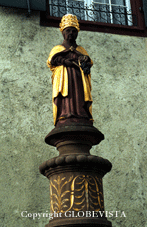St Urbans Fountain

Public Art: St Urbans Fountain
Also Known As: St Urbans Brunnen
Sculptor: © Carl Gutknecht (the 4th copy of the original). The original artist is unknown.
Description: The St Urban’s fountain features a statue of the Patron Saint of wine, Pope Urban I. Pope Urban’s three-tiered mitre (headdress) and cloak are gilded. In his left hand he holds out a bunch of dark grapes and in his right hand, he points his crosier (double cross staff) at the grapes.
Date Unveiled: c1448
Location: The St Urbans Brunnen is located outside number 24 Flower Rain Street (Blumenrain, Neben Haus 24), Basel, Switzerland.
History of the St Urbans Fountain: The fountain, which is either dedicated to Pope Urban I or Saint Urban of Langres (see Urban Controversy) was first erected in 1448. Unfortunately, over the years the statue of St Urban has been replaced 4 times. Firstly in the 16th century then in 1873, 1911 and 1953. The statue represents the patron saint of wine growers and wine merchants. Prior to the 1830s the locals decorated the statue with flowers on its tiara and dressed him in a purple velvet stole. They also placed a glass in each of its hands on St Urban’s Feast Day (25th May). One glass would be filled with white wine and the other with red. If it didn’t rain into the wine glasses during the whole day it would mean a good omen for the next year’s wine harvest. Today they celebrate but without the wine glasses placed in the statue’s hands.
The original statue was made from red sandstone and had a wooden trough. The trough was later replaced with an octagonal stone trough.
The second statue replica (1873) is now on display in the Historical Museum.
Urban Controversy
The original fountain was built “for Lauffenburg” who lived in the house behind it. He is believed to have named the statue Saint Urban, but which one was he thinking? Some believe the fountain is dedicated to Pope Urban I who held the Holy See from 222 until 230 but it is more likely named in honour of a bishop named Saint Urban of Langres.
Pope Urban I was believed to have been martyred after having toppled an idol off its column simply through prayer. This act led to a right beating and torture before he was sentenced to death by beheading on the 23rd of May. Recent scholars, however, have disputed this, believing he died from natural causes, not a beheading, as Urban’s pontificate was during a peaceful time for Christians. The mistake could be associated with Feast Day which falls on the 25th of May, which was 2 days after Pope Urban’s death and in the midst of the wine and grape growing season.
Saint Urban of Langres (327 – c390) was a French saint and bishop who is more likely represented by the statue. He is known as the patron saint of those who works in the wine industry.
When Urban became bishop of Langres (France) in 374 it wasn’t long before he was forced to flee thanks to political turmoil. He sought refugees in the numerous vineyards with the help of the local vine dressers. During this time he converted many of them to Christianity. The vine dressers then helped him move from town to town via their vineyards as he spread the word of god.
This is where the confusion lies, the Feast Day in Basel falls on the 25th of May, which was 2 days after Pope urban’s death and in the midst of the wine and grape growing season and the feast day of St Urban is celebrated on the 2nd of April, or 23rd of January in Langres, France.